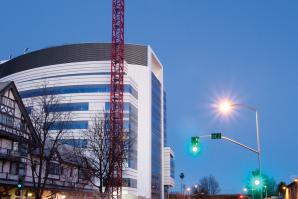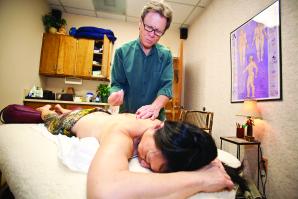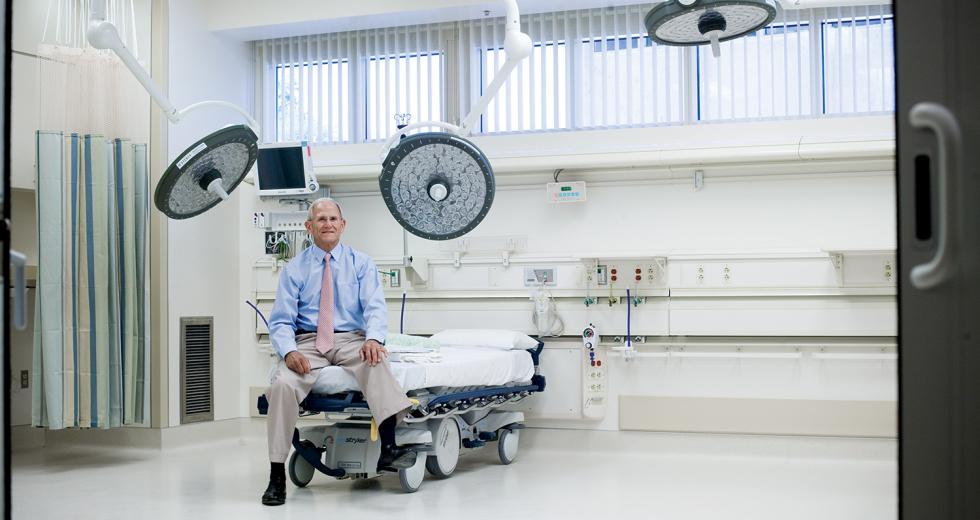Over the course of his lengthy career as an orthopedic surgeon, Dr. Michael Chapman transformed trauma care in the Sacramento area, saving countless lives along the way.
Now in retirement, Chapman has been leading the way in raising funds for UC Davis Medical Center’s new Surgery and Emergency Services Pavilion, a massive upgrade to the hospital that will almost certainly save more lives by providing much needed space for emergency care.
“We were frequently closed, maxed out [at] full capacity. We could not accept all of these patients,” Chapman says of the need for an expansion. “The private funding provides the little extra between being top tier and second tier.”
The new Pavilion most definitely is top tier thanks in part to Chapman’s fundraising efforts and a personal donation of $1 million. Scheduled for completion later this summer, the Pavilion has the cutting edge technology needed to provide top-flight emergency care. The 24 operating rooms are spacious and equipped with high-tech imaging systems.
The operating rooms are also outfitted with telecommunications equipment that will allow surgeons to consult with experts around the world or demonstrate surgeries to med students.
All told, there is nearly $50 million worth of medical equipment in the Pavilion, according to Mike Boyd, executive director of UC Davis Health System’s Facilities Design and Construction department.
During a winding tour through the Pavilion, Boyd pointed out highlight after highlight of the project. There was the state-of-the-art burn unit on the second floor that will serve a region far beyond Sacramento, a modern cafeteria near the medical center’s new entrance, a clinical lab with a $6 million robotics system that will more quickly turn around samples, and wide-open and comfortable waiting rooms to help family members relax. Meanwhile, computers were everywhere: in the walls, on wheels and bedside.
“We are essentially paperless,” Boyd says. “You can see computers everywhere.”
Because of the fast-paced nature of trauma and emergency work, the Pavilion’s streamlined design gets patients and sterilized equipment into emergency and operating rooms in seconds.
It’s also set up to make patients and their families as comfortable as possible with lots of natural light and plenty of space.
Light cascades down the hospital’s new main entrance, the new cafeteria comes with large private booths and many of the patient rooms offer privacy and windows. All of these features, big and small, make Chapman proud to have his name on the trauma and emergency department — it is formally called the Michael W. Chapman Emergency and Trauma Center.
During the tour with Boyd, Chapman seemed as excited about the natural lighting and comfy cafeteria booths as he was about the state-of-the-art equipment in the operating rooms. All of these details, he says, make for a better patient experience. “The design of the entire building is patient-centered,” Chapman says. “It’s designed to offer the highest level of care to our patients.”
Chapman’s excitement and pride in the project comes through loud and clear. So does his modesty. Having his name on the Pavilion’s emergency department and trauma center was an honor, he says, and yet it felt a little strange. The recognition went against his grain. “I feel really funny about that,” he says. “Trauma is very much a team sport. We always worked as a team. I felt funny being singled out.”
He had devoted his life to the medical center and developing trauma care, chairing UC Davis’ orthopedic surgery department for more than 20 years. During that time, Chapman transformed how trauma care is practiced throughout the nation, writing the book on it: “Chapman’s Orthopaedic Surgery.”
When Chapman was coming up as a doctor working at San Francisco General Hospital, there was no such thing as orthopedic surgeons specializing in trauma care. So Chapman was self-taught in how to respond to patients in critical situations.
“Our medical center has been operating at capacity for several years and, at times, we are forced to turn away all but the most seriously ill and injured patients.” —Ann Madden Rice, chief executive officer, UC Davis Medical Center
First the general surgeons would stabilize patients, and then the orthopedic surgeons would go in and fix things so the patients could be transported for more operations or care.
So, for example, if a person suffered a broken pelvis in a car accident, orthopedic surgeons would fix the broken pelvis about five days after the patient was initially stabilized. “We’re the guys who put the patient back on their feet,” Chapman says.
When he left San Francisco General to head the UC Davis Department of Orthopaedic Surgery, he started a program to aggressively treat patients with multiple injuries.
While heading the department, Chapman implemented a new approach to treating severe fractures, which resulted in dramatically improved recovery times for thousands of patients.
After he launched the trauma program, the preventable death rate plummeted to less than 1 percent in Sacramento County.
“He changed the way health professionals approach trauma care and in the process has saved countless lives,” said Ann Madden Rice, chief executive officer for the UC Davis Medical Center, in an email interview.
And in his retirement he has played a key role in building support for the new Pavilion, serving as the chair for the Pavilion fundraising committee.
“Dr. Chapman has been instrumental in generating enthusiasm and excitement among our donors about the importance of this facility and the impact it will have on the lives of those we serve,” Madden Rice says.
For Madden Rice and others at UC Davis Medical Center, the $424.5 million Pavilion expansion was a long time coming.
Although the existing hospital has 24 operating rooms — the same number as the Pavilion — many of the rooms were too small to perform needed surgeries, meaning high demand for the big operating rooms.
The result meant patients were turned away from Sacramento’s only level-one trauma center. Meanwhile, scheduling some complex surgeries has been a challenge.
“Prior to the start of construction on the Pavilion eight years ago, the demand for the specialty services and expertise that only we provide had outgrown our facilities,” Madden Rice says. “Our medical center has been operating at capacity for several years and, at times, we are forced to turn away all but the most seriously ill and injured patients.”
Because the Pavilion’s operating rooms are big enough to handle the most complex surgeries, there is much greater flexibility in terms of scheduling and space. “When you have operating rooms like these, you have significant flexibility,” says Boyd, head of UC Davis Health System’s Facilities Design and Construction department.
The long-term plan is to refurbish eight of the older operating rooms, so in the end the medical center will have 32 rooms to work with.
For Chapman, the Pavilion represents a new era for the medical center, and a new era for health care in the Sacramento region. “There is a lightness to the building. The new operating rooms are fabulous,” he says. “It makes me almost want to go back and be a surgeon.”
Three projects on the horizon
Pediatric Intensive-Care Unit:
Under construction since March, the new unit will be located on
the 10th floor of the Davis Tower at UC Davis Medical Center. The
pediatric intensive-care unit will double in size to 25,000
square feet and will increase the number of beds from 16 to 24.
California Telehealth Resource Center:
The new building should be finished by the fall of next year, and
will enhance UC Davis’ use of high-speed telecommunications for
medical consultations, training, critical care and emergency
services in underserved areas.
UC Davis Cancer Center:
An expanded facility will provide more space for adult patients,
bring pediatric patients into the same building and include a
36,000-square-foot research center. The expansion should be
finished by spring 2012.
Source: Ann Madden Rice, CEO, UC Davis Medical Center
Recommended For You

Finishing Touches
Sutter Health construction completion in sight
After more than a decade of work and a price tag that has grown by 50 percent, representatives for Sutter Medical Center, Sacramento report that the $750 million midtown hospital upgrade is in the final phases and is expected to be finished by mid-2014.

New Age of Medicine
Mainstream health providers take an integrative approach
With conventional health care becoming more technologically advanced and increasingly expensive, Dr. Maxine Barish-Wreden sees the future of medicine embracing meditation, massage, yoga, tai chi, nutrition and other “softer therapies.”



